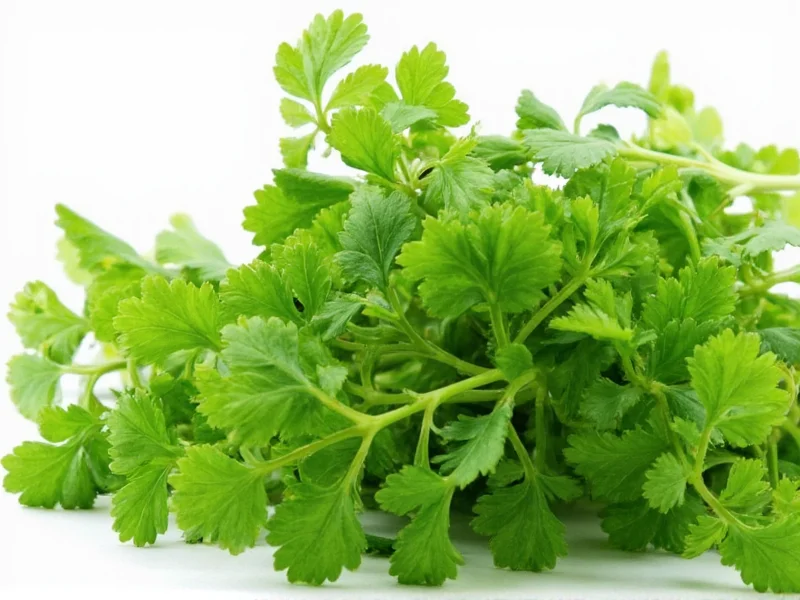Understanding the difference between fresh coriander (often called cilantro in the United States) and ground coriander seeds is crucial when seeking replacements. This terminology confusion causes many home cooks to search for what is a replacement for coriander without specifying which form they need. In many regions outside North America, "coriander" refers to both the fresh herb and the dried seeds, while in the US, "coriander" typically means the seeds and "cilantro" refers to the fresh leaves.
Substitutes for Fresh Coriander (Cilantro)
When your recipe calls for fresh coriander leaves (cilantro) and you're out, several herbs can step in. The best replacement depends on your dish's flavor profile and what's available in your kitchen. Many home cooks searching for best substitute for fresh coriander in recipes don't realize that different alternatives work better for specific cuisines.
Parsley remains the most versatile substitute for fresh coriander, offering similar texture with a milder, grassier flavor. Use it in equal amounts as a direct replacement. For Mexican or Asian dishes where coriander's distinctive citrus note is essential, consider these alternatives:
| Substitute | Best For | Ratio | Flavor Notes |
|---|---|---|---|
| Parsley | All-purpose replacement | 1:1 | Milder, less citrusy |
| Basil | Thai or Mediterranean dishes | 1:1 | Sweeter, anise notes |
| Mint | Indian or Middle Eastern recipes | 1:1 | Cooler, more intense |
| Arugula | Salads or garnishes | 1:1 | Peppery, stronger flavor |
| Dill | Fish dishes or tzatziki | 1:1 | Grassy, slightly sweet |
Substitutes for Ground Coriander Seeds
When you need a replacement for ground coriander seeds, the flavor profile shifts to warm, citrusy, and slightly sweet notes. Many people searching for what spice can replace coriander in curry don't realize that curry powder or garam masala already contain coriander as a primary ingredient.
Cumin provides the closest flavor match for ground coriander, sharing earthy, warm characteristics with a slightly more intense profile. Use 3/4 teaspoon of cumin for every 1 teaspoon of coriander required. For more complex dishes, consider these alternatives:
- Garam masala (use 3/4 amount): Contains coriander plus other warming spices
- Curry powder (use 3/4 amount): Typically 25-50% coriander by volume
- Fennel seeds (use 1:1 ground): Sweeter, licorice notes work well in Indian dishes
- Caraway seeds (use 3/4 amount): Similar earthy profile but more pungent
Regional Considerations for Coriander Substitutes
Your location significantly impacts which substitute works best. In regions where coriander substitute UK vs US differs, understanding local terminology prevents recipe disasters. British recipes listing "coriander" often mean the fresh herb, while American recipes typically specify "cilantro" for the leaves and "coriander" for the seeds.
For Indian or Middle Eastern dishes requiring fresh coriander, try mixing equal parts parsley and mint to approximate the distinctive flavor. In Mexican cuisine, where coriander's citrus notes are essential, adding a squeeze of lime juice with your parsley substitute can help bridge the flavor gap.
Practical Substitution Tips
When determining how to replace coriander in specific recipes, consider these professional chef tips:
- For salsas and fresh dishes: Combine parsley with a few drops of lime juice to mimic coriander's citrus notes
- For curries and stews: Blend equal parts cumin and fennel seeds for a closer flavor match to ground coriander
- For baking: Cardamom works surprisingly well as a coriander seed substitute in sweet applications
- For marinades: Add a pinch of lemon zest when using parsley as a fresh coriander substitute
Remember that no substitute perfectly replicates coriander's unique flavor profile. The key is understanding which aspect of coriander your recipe needs most—its citrus notes, earthy warmth, or fresh herbal quality—and choosing a substitute that addresses that specific characteristic.
When Substitutes Won't Work
Some dishes rely so heavily on coriander that substitutes significantly alter the final product. Traditional chimichurri, certain Indian chutneys, and Vietnamese pho broth depend on coriander's distinctive flavor. In these cases, consider these alternatives:
- Make a special trip to the store for fresh coriander
- Grow your own coriander in a small pot (it grows quickly indoors)
- Adjust your menu to a dish that works with available ingredients











 浙公网安备
33010002000092号
浙公网安备
33010002000092号 浙B2-20120091-4
浙B2-20120091-4